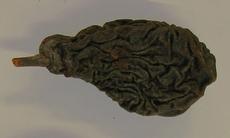Acrylamide in dried Fruits
Heated foods can be dangerous, we learned last summer. Now we are finding out that some dried fruits may not be as wholesome as once believed. The villain in both cases is acrylamide, linked in 2002 to such snacks as potato chips and French fries as well as bakery products. Avoid fried foods, we were told then, and all would come right. “Think again” says a recent ETH Zurich study.

Dr Thomas Amrein and his colleagues at ETH Zurich’s Institute of Food Science and Nutrition (D-AGRL) suggest that the usual suspects may not be the only sources of acrylamide. By focussing on fruit, until now thought to be unimpeachable (as it were), they have revealed new complexities to the acrylamide debate.
With heated foods, the thinking was that acrylamide was formed only at high cooking temperatures, and especially in starchy foods. But Dr Amrein and his team have found its presence in dried fruit as well. The significance of their discovery is that fruit is dried at a relatively low temperature (around 70C°), well beneath the range that earlier thinking suggested was necessary to provoke formation of acrylamide.
Dr. Amrein uses the example of dark, dried whole pears. The ETH Zurich researchers have found that these pears, along with dried prunes, contain surprising amounts of acrylamide. "They are dried at 70°C over a long period of time, which means that acrylamide is formed under mild conditions", Dr Amrein says. That discovery may lead to a major re-assessment of some natural foods which have always been considered as healthy and natural alternatives to fast food.
Low vs high temperatures
Until now, acrylamide was thought to form when a specific amino acid (asparagine) and sugars found in foods reach temperatures of 100C° - 120C° (about 212F) or above. This phenomenon is known as the Maillard reaction, and was assumed to be limited to starchy foods. “In starchy foods”, Dr. Amrein explains, “the precursors for acrylamide formation occur naturally. That means free asparagine and reducing sugars (glucose and fructose) are present. This combination, together with temperatures of 120°C or higher, creates the conditions under which acrylamide forms.”
The culprit: acrylamide
In scientific terms, acrylamide is a small, simple 3-carbon molecule. Its official name is 3-propenamide, and it is “classified as a probable human carcinogen”, Dr. Amrein points out. It is readily taken up and distributed in the body, and then quickly excreted. “However, a small part may be expoxidised in the liver to glycidamide, which likely is the toxic form of acrylamide”.
Dr Amrein suggests that current knowledge of acrylamide has to be expanded before a clear picture emerges. “Further research is clearly needed before an answer can be given. The ETH Zurich study was not large enough to clearly categorise dried fruit in terms of acrylamide, or assess the danger levels of it in dried fruit”.
Addressing the reasons for higher concentrations of acrylamide in dried pears and prunes compared to other dried fruit, Dr. Amrein explains that different fruits have varied compositions: different amounts of precursors for acrylamide formation. And the drying process can change according to the fruit. As an aside, he says that acrylamide is absent in raw fruit.
FAQ about Acrylamide
So what is the healthiest
approach, to cook, fry, bake or grill? Thomas
Amrein is cautious with his cooking tips. “The situation is much too complex to consider it only
in terms of cooking. The raw ingredients and the recipes also have a strong
influence. In the case of potatoes, you usually get lower acrylamide levels if
you bake them in an oven instead of deep-frying in oil”.
Is browning foods dangerous?
”As a rule, cooked food should be golden. Don’t brown it.”
Brown cane sugar, white sugar
or honey? Syrup or molasses? Which of
them is better for cooking?
“For acrylamide formation, white and brown sugars are,
equally, no problem. Honey and inverted
sugar syrup and similar products produce more [of the] reducing sugars that
provoke acrylamide formation”.
Which is better to use, baking powder or
baking soda?
”Baking soda (sodium hydrogencarbonate, NaHCO3, E501) promotes
acrylamide formation much less than baking powder (ammonium hydrogencarbonate,
NH4HCO3). So
if possible, I avoid ammonium
hydrogencarbonate (E 503)”.
Is it fair to say of sweet bakery goods,
such as gingerbread, that the darker the product, the higher the concentration
of acrylamide?
“If you have gingerbread dough
and you bake it in two separate batches, then the darker batch will contain
more acrylamide. Some products have a
dark colour, but are not particularly rich in acrylamide. Different factors play a role, which makes the
whole problem a bit complicated”.
Dr Amrein reminds us that
acrylamide formation and browning both are part of the Maillard Reaction. It seems that pleasing the eye and the
palette has to be balanced with a side order of healthy prudence.







READER COMMENTS